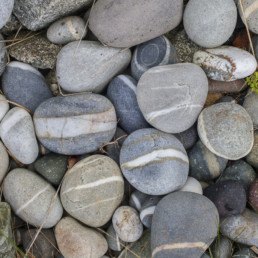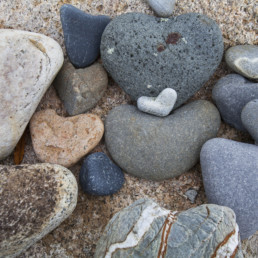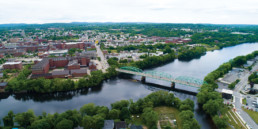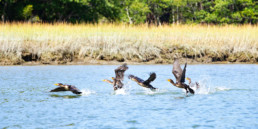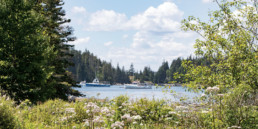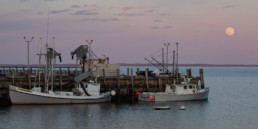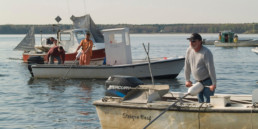Dialed Back in Time
The carved and polished past on Maine’s beaches.
STORY BY DANA WILDE
PHOTOS BY PETER RALSTON
Twenty thousand years ago, the snow was deep in Maine. Really deep.
America for about 60,000 years. Not much of it was melting. Snowfall after snowfall built up, packing the layers into ice and more ice. By about 21,000 years ago, a mile-and-a-half-thick layer of ice covered this part of the world, extending over mountains and easterly over the ocean as far as 180 miles from the present coastline. Geologists call this the Laurentide Ice Sheet. The rest of us, unable to do much more than scratch our heads about that much ice, just call it a glacier.
That much ice was heavy. It pushed down on the land underneath, depressing it hundreds of feet lower than it is today. Between about 12,000 and 20,000 years ago, the atmosphere began to warm and the glacier retreated as the ice age known as the Wisconsin period of glaciation came to an end. By around 16,000 years ago, the coastline was starting to show, and by 14,000 years ago the tops of Cadillac and other mountains were poking out.
We say the glacier “retreated,” but this is a little misleading; more accurately put, what happened is that the glacier melted from its margin back inland. The ice itself plodded seaward the whole time, even while it was melting and breaking off in chunks (as glaciers are doing now in Alaska and other parts of the world). As the weight of the ice diminished, the land sprang back up. By 10,000 to 12,000 years ago, our lowland areas were clear.
A lot of rubble was left.
Receding glaciers leave all sizes, shapes, and conditions of rock—churned up, scarred, abraded. Just to give a few geological examples: There’s till, which is silty, sandy rock debris; the bits ground up underneath the glacier are called basal till. Accumulations of soil and rocky material left by the glacier are called moraines. Sand and gravel deposits from melted water flowing in tunnels are called eskers.
Much of the material that makes up till, moraines, and eskers is hundreds of millions of years old. The glacier was just the most recent form of processing. In fact, Maine’s coast began to take shape in its present jagged form when wandering land masses collided around 430 million years ago. A fragment of continental land (or terrane) called Avalonia—which was connected with land that now makes up parts of Europe—plowed into the proto–North American continent, or Laurentia.
In the slow-motion collision, sedimentary, igneous, and metamorphic rock that was already there turned up from the ocean bed and folded over and under. As hundreds of millions of years churned by, the continents continued to drift, until what’s now the Atlantic Ocean opened up around 1.7 million years ago. Periods of glaciation over the next million and a half years sculpted the rocks and stones we see now, from the sandy beaches of southern Maine to the cliffs of Monhegan, mountains of Mount Desert, and Washington County coast.
Evidence in Rock
The evidence of these ancient forces is everywhere in the rock, if you know how to look, and among the most alluring of its smaller bits are the smooth cobblestones and pebbles you see piled and crowded together on some beaches.
Naturally polished, intriguingly marked beach stones, as they’re often called, are found worldwide. In Maine, they’re less numerous on the sandy southern shore, but more abundant up through the rockier Midcoast to Penobscot Bay and Downeast. The most well-supplied beaches are often tucked into an island or coastal cove, many times between bedrock outcrops that frame the strand. This means, as Maine Geological Survey writers observe, that waves washing up the “pocket beach” can’t move the stones very far to either side, where they could otherwise be washed out to deeper water.
Instead, the stones are rolled again and again up and down the beach by the waves, tides, and storms. These clinking, clattering collections of cracked and broken rock are the junk whittled down through the eons—from the geologic folding (a component of orogeny, the processes of deformation of the Earth’s crust) set up in the Avalonia collision, through to the glaciers, and finally into our Holocene geologic epoch, in which the stones are chipped round and polished by the relentless friction of water, waves, and each other.
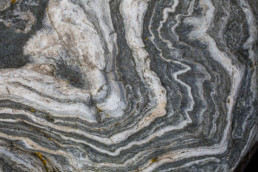
The larger ones, suitable in past centuries for paving streets and finishing buildings, are called cobblestones. Smaller ones are pebbles—defined by geologists as stones measuring between 4 millimeters and 6.4 centimeters across. They’re often difficult even for geologists to readily identify, in part because they’re made variously of all three different basic kinds of rock: igneous (solidified from magma, such as granite and basalt); sedimentary (solidified by massive, long-term pressure, such as sandstone and limestone); and metamorphic (chemically changed by tremendous heat and pressure, but not melted, such as gneiss and marble).
In her book Beach Stones, Margaret Carruthers pictures stones so finely detailed they seem almost to be works of art. A 400-million-year-old metamorphic stone found on North Haven is lined with a tangle of white jags that Jackson Pollock would have appreciated. Another from Vinalhaven is a trapezoidal chunk of gray quartzite shot through with a thick line of white quartz that formed when hot water ran into a rupture in the sandstone and sealed the different quartz materials. One from Brimstone Island, which lies roughly between Vinalhaven and Isle au Haut, is a smooth, shiny, elongated piece of brimstone, a basaltic rock.
Pretty stones are free for the taking on some beaches; jewelry-makers, recognizing the natural artistry, scavenge for them to make necklaces and even earrings when suitably matched pebbles can be found.
Beach-Stone Beaches
Where are the best beach-stone beaches in Maine? Some are well-known, such as Jasper Beach in Machiasport, which has good examples of the “storm berms,” or ridges of stones thrown up by storm waves. But stone jewelers like Barbara Fernald, of Islesford, and Anita Roelz, of Woolwich, decline to name their favorite collecting beaches.
“I see myself as a steward of the places I choose my stones,” Roelz said in reply to the question. The stones, she said, are a natural resource, which can be abused.
Indeed, the rangers of Acadia National Park keep a close eye on the stone beaches there, where Monument Cove, Little Hunters Beach, and Seawall are particularly prone to beachcombing for stones.
Law Enforcement Field Ranger Chris Wiebusch said recently that during the summer, warnings—and sometimes violation notices—are issued fairly often to people trying to carry off pieces of the beaches.
“Animals live in the rocks” in their own little beach ecosystems, Wiebusch said, and in any case, “the beach isn’t an art gallery.
“It’s prohibited to take any resources from the park,” he said.
And that includes not only pebbles but larger items. Wiebusch said rangers once stopped a person from loading a huge slab of granite into his car on Cadillac Mountain. And some years ago, when the federal Transportation Security Administration stepped up its routines in the Hancock County–Bar Harbor Airport, the park started receiving calls from TSA officials reporting stones—sometimes bags of them—stowed in people’s luggage. The rangers had to drive to the airport, collect the confiscated stones, and return them to the shore.
What’s the allure, exactly?
Well, no doubt it’s the aesthetic attractiveness of the stones, as the success of Barbara S. Fernald Jewelry and Roelz’s Circle Stone Designs, among many others, attests. But the visual beauty seems to be surficial, to steal a term from the geologists.
Roelz described her stone collecting as a process undertaken in “places that have interesting energy,” a phrase that might hold a clue to the fascination for the stones. She said that in more secluded coves she detects a “different kind of energy . . . coming from a whole different part of the Earth,” especially when she comes upon stones of “deep green” (whose colors result from the presence of iron minerals formed in oxygen-poor environments).
Such stones are “energy-enriched,” Roelz said, adding: “It dials you back in time.”
For indeed, when you pick up these perfectly polished and rounded stones, you’re holding in your hand Earth’s ancient past—12,000 years past, to the melting of the glacier and the grinding of the stones; to 21,000 years ago, when Cadillac Mountain slept deep beneath the ice; to 80,000 years ago, when the Wisconsin glaciation began; and much further back, to the hyper-ancient collision of Avalonia and Laurentia.
On Maine’s beaches, you can touch the carved and polished past that lay for eons deep beneath the glacier.
Dana Wilde is a former English professor and newspaper editor who lives in Troy in northern Waldo County. The Other End of the Driveway is a collection of short essays gathered from his Amateur Naturalist columns that have appeared in several Maine daily newspapers.
Sources for this article include the Maine Geological Survey’s Explore Maine Geology and Geologic Site of the Month reports; Margaret W. Carruthers’s book Beach Stones (Abrams, 2006); Andrew M. Barton’s book The Changing Nature of the Maine Woods (University of New Hampshire Press, 2012); and carefully selected online sites, such as Geological History of Jamestown, Rhode Island, and Gulf of Maine Council on the Marine Environment, to help clarify and detail information.

